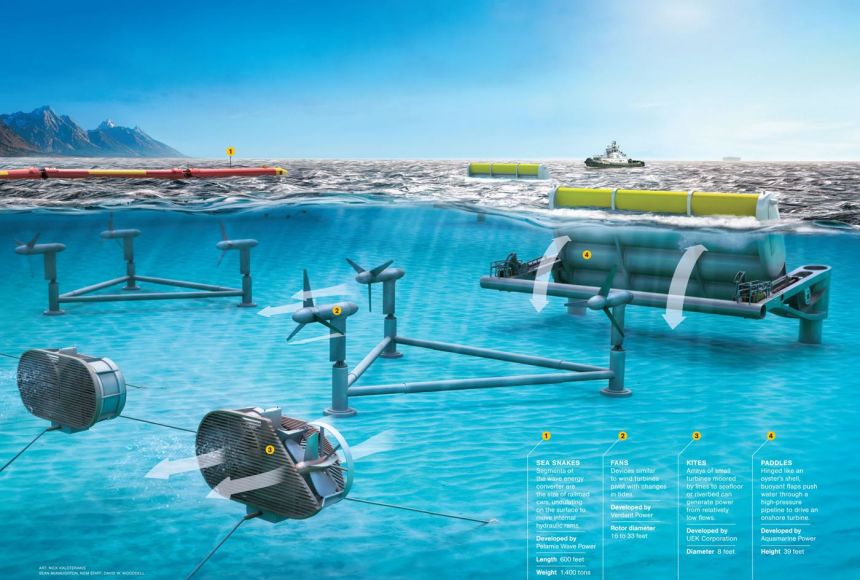How Does Wave Energy Work?
Wave energy is generated by the movement of ocean waves. This energy can be harnessed through a variety of methods, including using the up-and-down motion of the waves to power a turbine or using the pressure of the waves to force air through a turbine.
One common method of harnessing wave energy is through the use of a “point absorber” device. This device consists of a buoy that floats on the surface of the water and is attached to a generator on the ocean floor. As the waves move the buoy up and down, it drives the generator, producing electricity.
Another method is the use of “oscillating water column” devices, which consist of a partially submerged chamber that captures the wave energy as it enters and exits the chamber, driving a turbine and producing electricity.
How Does Tidal Energy Work?
Tidal energy is generated by the movement of ocean tides. This energy can be harnessed through the use of tidal barrages, which are large dams that are built across the mouths of estuaries or bays. As the tide rises and falls, water flows in and out of the estuary or bay through turbines, generating electricity.
Another method of harnessing tidal energy is through the use of “tidal stream” devices, which are similar to wind turbines but are designed to capture the kinetic energy of moving water. Tidal stream devices can be placed in ocean currents, where they can generate electricity from the continuous movement of the water.
Advantages of Wave and Tidal Energy
Wave and tidal energy have several advantages over other forms of renewable energy, including:
Predictable and reliable: Unlike solar and wind power, which are subject to variations in weather conditions, wave and tidal energy are predictable and consistent.
High energy density: The energy density of waves and tides is much higher than that of wind or solar power, which means that a relatively small amount of equipment can generate a large amount of electricity.
Low environmental impact: Wave and tidal energy have a relatively low environmental impact compared to fossil fuel power generation. They do not produce greenhouse gas emissions or air pollution and have minimal impact on land use.
Long lifespan: Wave and tidal energy devices have a long lifespan, typically lasting 20-25 years or more with regular maintenance.
Challenges and Considerations
Despite their many advantages, there are some challenges and considerations associated with wave and tidal energy. One of the primary challenges is the high cost of installation and maintenance, particularly for offshore devices. Additionally, the harsh ocean environment can make it difficult to access and repair devices.
Another challenge is the potential impact on marine ecosystems. Tidal barrages can disrupt the natural flow of water, which can affect fish and other marine species. Tidal stream devices can also pose a risk of collision with marine animals, although efforts are being made to minimize this risk through careful design and placement.
Conclusion
Wave and tidal energy are two exciting and promising sources of renewable energy that have the potential to play a significant role in our energy mix. While there are challenges and considerations associated with their use, ongoing research and development are helping to overcome these barriers and make wave and tidal power a viable option for power generation in the future.



